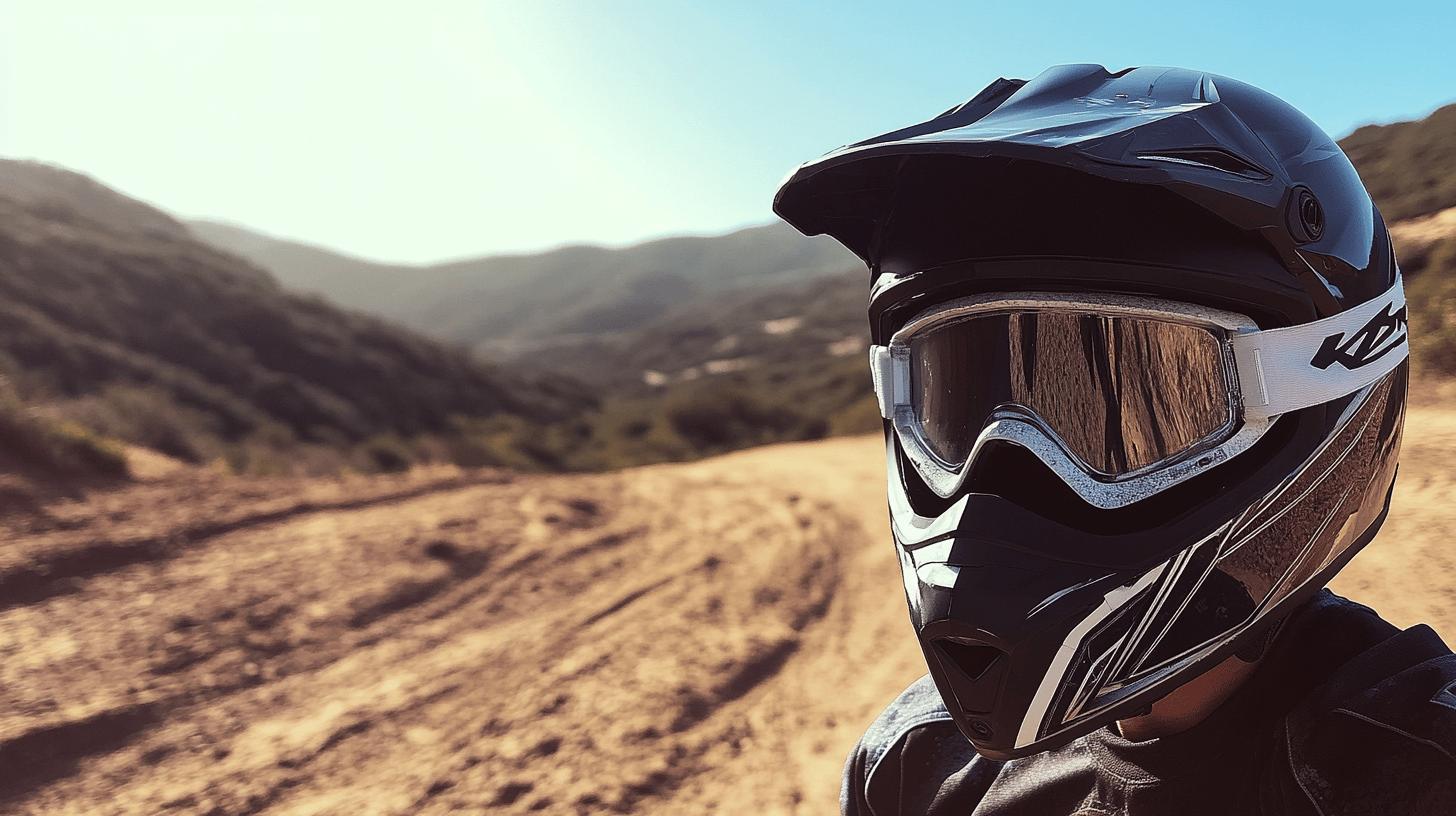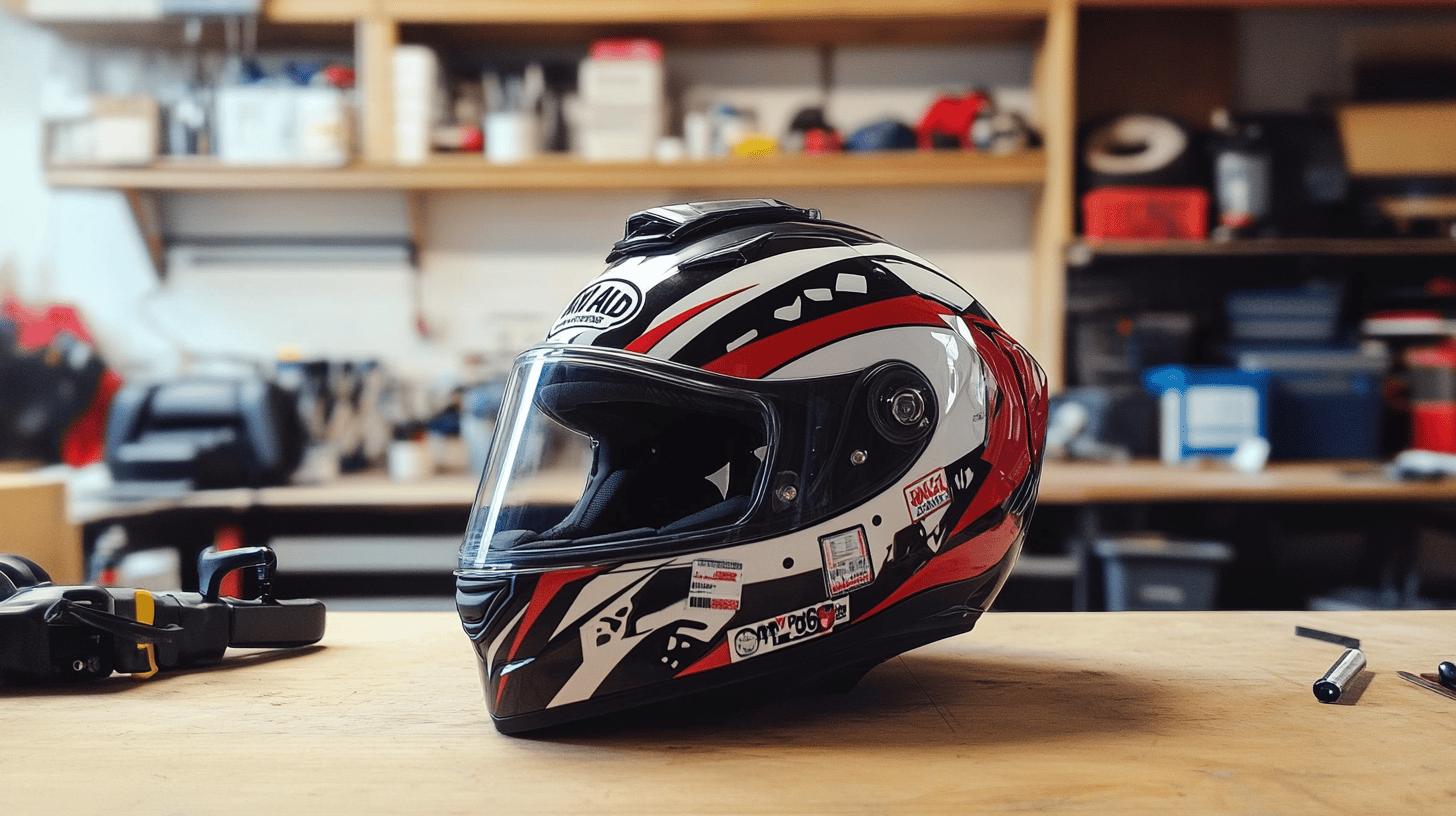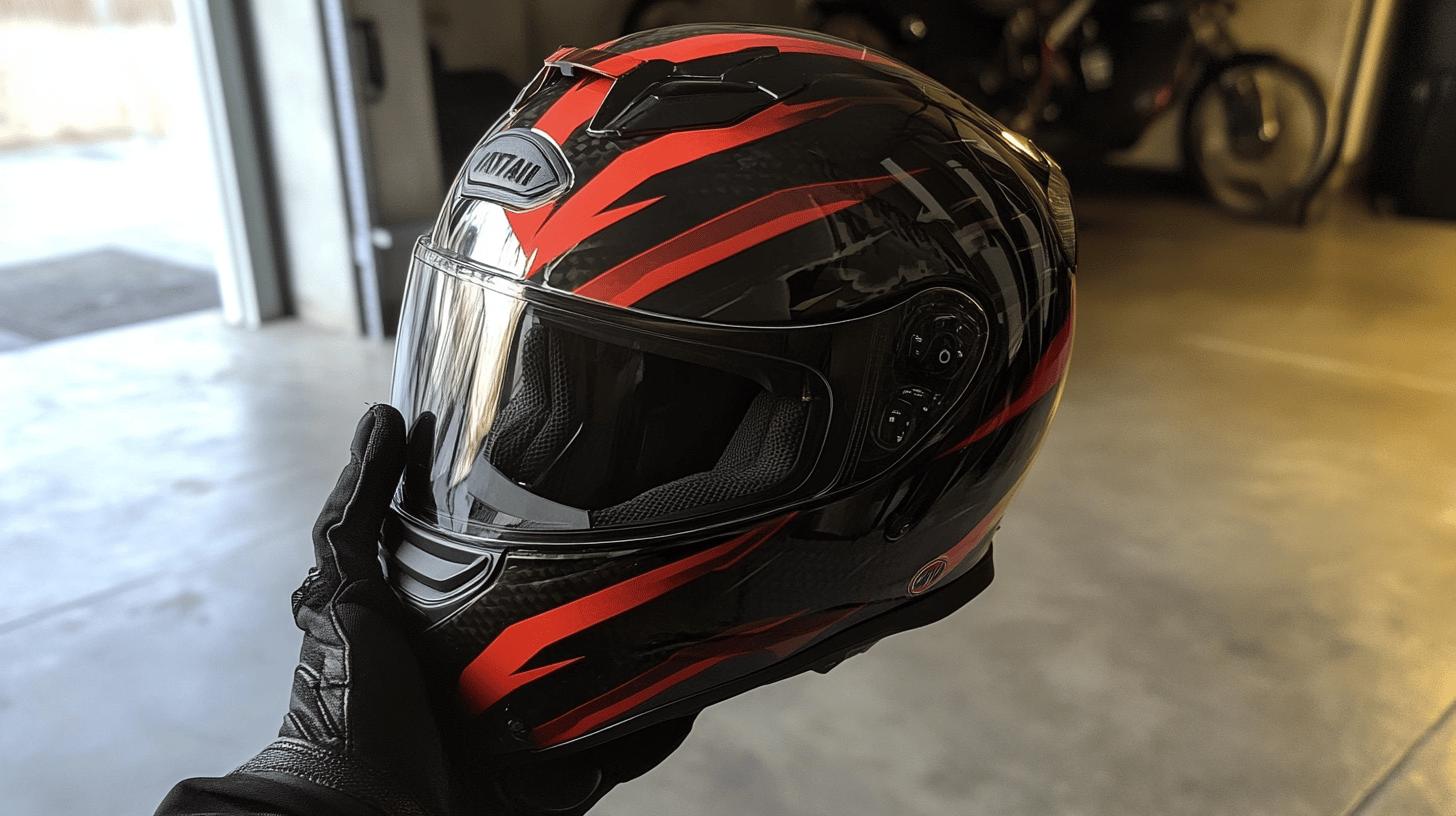Do you know that choosing the right motorcycle helmet can be the difference between life and death on the road? With a staggering variety of helmets available, understanding the unique benefits and drawbacks of each type is crucial for every rider.
From full-face helmets offering maximum protection to versatile modular designs, each category serves a distinct purpose. This guide explores the various helmet types, guiding enthusiasts toward a safe and satisfying ride.
By delving into features and safety standards, riders can feel more confident and comfortable while riding. Let's strap in and discover the helmet that best suits your riding needs.
Exploring Full-Face Helmets and Their Benefits

Full-face helmets are recognized as the pinnacle of safety in motorcycle headgear, providing unmatched protection by encompassing the entire head, including the skull base and jawline.
This comprehensive coverage is crucial, especially during high-speed or off-road riding where the risk of impact is significantly higher. Their design includes a fixed visor and chin bar, offering a robust barrier against potential hazards.
Riders can rely on these helmets to shield them from debris, harsh weather conditions, and severe impacts. Statistically, full-face helmets are the safest option, reducing the risk of facial injuries which occur in nearly 50% of severe crashes.
-
Constructed from materials like fiberglass, carbon fiber, or polycarbonate for superior durability.
-
Equipped with micrometric or double buckle closures for secure fastening.
-
Designed to meet safety standards such as DOT and ECE certifications.
-
Includes an integrated visor for enhanced visibility and facial protection.
-
Offers aerodynamic efficiency to minimize drag at high speeds.
Full-face helmets truly shine in scenarios demanding maximum safety, such as high-speed highway cruising or adventurous off-road trails. Their aerodynamic design not only improves stability but also reduces wind noise, providing a quieter ride.
Off-road enthusiasts appreciate the enhanced protection, allowing them to tackle rugged terrains with confidence. For sports riders, these helmets ensure both safety and performance, accommodating the aggressive riding positions often required in racing environments.
The full-face helmet is an indispensable piece of gear for those prioritizing safety without compromising on comfort and functionality.
Versatility of Modular Helmets

Modular helmets, often referred to as flip-up helmets, are a fusion of the protective qualities found in full-face helmets and the convenience of open-face designs. They feature a unique hinge mechanism that allows the chin bar and visor to flip up, offering riders the flexibility to enjoy both full coverage and open-air freedom.
This versatility makes them suitable for various riding conditions, from city commutes to long-distance tours. While modular helmets provide more protection than open-face models, it's important to note that they are slightly less secure than full-face helmets due to the structural compromises inherent in the hinge design.
Nevertheless, their ability to offer ventilation and easy communication at lower speeds makes them a popular choice among riders who prioritize adaptability.
Modular Helmet Innovations
Recent innovations in modular helmets focus on enhancing both safety and convenience. Advances in hinge technology have improved the durability and ease of use, ensuring that the flip-up mechanism remains reliable over time.
Many modern modular helmets now come equipped with integrated communication systems, such as Bluetooth, allowing riders to connect with fellow motorcyclists or access navigation tools hands-free. These technological enhancements not only boost the helmet's functionality but also elevate the overall riding experience by offering seamless connectivity and interaction on the road.
Modular helmets excel in scenarios where adaptability is key. They are particularly favored by touring riders who appreciate the ability to switch between full-face protection and open-face comfort as needed.
In urban environments, the convenience of flipping up the visor for quick interactions or increased airflow makes them ideal for city riding. Their multifunctional nature caters to a broad spectrum of motorcycling activities, making modular helmets a versatile and practical choice for diverse riding styles.
Open-Face Helmets: Style and Airflow

Open-face helmets, frequently referred to as ¾ helmets, are designed to cover the top, sides, and rear of the head, while leaving the face exposed. What makes open-face helmets popular among urban riders?
Their design allows for a more stylish and lightweight option, ideal for those navigating city streets on scooters or lower-speed motorcycles. The absence of a chin bar contributes to their aesthetic appeal, offering a retro vibe that resonates well with café racer and cruiser enthusiasts.
However, this lack of a structural chin section also means reduced protection compared to full-face helmets, a trade-off that some riders are willing to make for style and comfort.
The key advantage of open-face helmets lies in their superior airflow and comfort, particularly beneficial in warmer climates. How do open-face helmets improve comfort during hot weather?
By allowing significant ventilation, these helmets help keep riders cool, making them a practical choice for city commutes where frequent stops might otherwise lead to overheating in more enclosed helmets. Despite their comfort and style advantages, it's critical to recognize the safety limitations associated with open-face designs.
The exposed facial area increases vulnerability in the event of an accident, highlighting the importance of assessing riding conditions and personal safety preferences when choosing this type of helmet.
Understanding Half Helmets and Their Limitations

Half helmets, commonly known as "shorty" helmets, are designed to cover only the top of the head and forehead. This minimalist design allows for increased airflow and a lighter weight, making them a stylish choice among riders who value comfort and ventilation.
The reduced coverage means these helmets typically lack integrated visors or face shields, necessitating additional eye protection, such as goggles or sunglasses. Their open design makes them particularly appealing for short, casual rides where the feel of the wind and peripheral vision are prioritized.
Despite their stylistic appeal and comfort benefits, half helmets come with significant safety limitations. They provide minimal protection compared to full-face or even open-face helmets, as they leave the face, ears, and neck exposed to potential hazards.
This vulnerability makes them unsuitable for high-speed or long-distance rides where the risk of impact is greater. Half helmets are best suited for leisurely, low-speed trips, where the emphasis is on enjoying the ride rather than maximizing safety.
Riders should carefully consider their intended use and risk tolerance when selecting a half helmet, balancing style preferences with safety needs.
Off-Road and Dual-Sport Helmets: Designed for Versatility

Off-road helmets, commonly referred to as dirt bike helmets, are engineered with lightweight materials and a one-piece construction that maximizes airflow, making them perfect for the demands of off-road riding.
The design includes a pronounced chin bar that provides enhanced protection against debris and impacts, which are common in rugged terrains. The larger visor not only helps shield the eyes from the sun but also accommodates the use of goggles, an essential feature for riders tackling dusty or muddy conditions.
This type of helmet is specifically crafted for situations where ventilation and protection are paramount, allowing riders to maintain comfort and focus during physically demanding rides.
-
Large visors to improve visibility and protect against sun glare.
-
Robust ventilation systems that enhance airflow for improved comfort.
-
Lower chin bars for added protection while maintaining versatility.
- Integration of comfort padding similar to full-face helmets for long rides.
Dual-sport helmets bridge the gap between off-road and on-road riding, offering features that cater to both environments. With the structural characteristics of off-road helmets like the pronounced chin bar and large visor, they also incorporate the comfort and padding typical of full-face helmets.
This combination makes them a versatile choice for riders who transition between highways and trails. The hybrid nature of dual-sport helmets means they can effectively manage varied riding conditions, providing the durability needed for off-road trails while ensuring the aerodynamic efficiency required for highway speeds.
Their adaptability makes them a popular choice for adventure riders seeking a helmet that performs well across diverse terrains.
Helmet Safety Standards and Certifications Explained

Helmet safety standards play a critical role in the manufacturing process, ensuring that each helmet meets specific criteria for protecting riders. These standards evaluate a helmet's ability to withstand impacts, maintain structural integrity, and provide adequate protection in various riding scenarios.
By adhering to these guidelines, manufacturers can assure riders that their helmets will perform effectively during accidents. Safety standards not only dictate the materials and design of the helmets but also influence the testing methods used to assess their durability and protection levels.
The most recognized helmet safety certifications include DOT, ECE, and Snell, each offering unique testing protocols. DOT (Department of Transportation) certification is mandatory in the USA, focusing on impact resistance and penetration protection. ECE (Economic Commission for Europe) certification is widely accepted in over 50 countries and emphasizes rigorous testing across multiple criteria, including environmental impacts.
Snell certification, a voluntary standard, is known for its stringent testing procedures, often exceeding those of DOT and ECE, providing an extra layer of confidence in a helmet's safety capabilities.
These certifications significantly impact a helmet's performance by ensuring it meets or exceeds the minimum safety requirements. Helmets that have been certified are more likely to offer superior protection in real-world incidents, making certification a vital consideration for riders.
When purchasing a helmet, riders should look for labels indicating DOT, ECE, or Snell certification, as these signify adherence to recognized safety standards. Beyond the labels, understanding the differences in certification processes can help riders make informed choices about the level of protection they desire.
Choosing the Right Helmet: Sizing and Comfort

Proper helmet sizing is paramount to rider safety. How does helmet size affect protection? The correct size ensures that the helmet remains securely in place during a crash, significantly enhancing its protective capabilities.
To find the right size, measure the head circumference just above the eyebrows, which provides a baseline for selecting the correct fit. Keep in mind that helmet brands may vary in sizing, making it crucial to try on different models.
A well-fitted helmet should be snug but not overly tight, allowing for minimal movement when the head is shaken. Poorly fitting helmets can compromise safety, comfort, and concentration, thus detracting from the riding experience.
-
Padding: Soft inner padding provides comfort and absorbs sweat.
-
Ventilation: Adequate airflow helps regulate temperature and reduce fogging.
-
Noise Reduction: Enhanced lining can minimize wind noise, improving focus.
-
Weight: A lightweight helmet reduces fatigue on long rides.
-
Moisture-Wicking Liners: These liners keep the interior dry and comfortable.
When trying on helmets, what should riders look for? Start by placing the helmet on the head and securing the chin strap. The helmet should sit level on the head without tilting forward or backward. Check for pressure points by wearing the helmet for a few minutes; discomfort indicates an improper fit.
Additionally, ensure the helmet doesn’t shift when you move your head side to side or up and down. Taking the time to find a helmet that fits properly and offers the necessary comfort features can vastly improve both safety and enjoyment on the road.
Advanced Features in Modern Motorcycle Helmets

Bluetooth communication systems have become a staple in modern motorcycle helmets, transforming how riders interact on the road. These systems allow seamless communication between riders, enabling hands-free calls, music streaming, and GPS navigation.
How do Bluetooth helmets enhance communication? By integrating speakers and microphones directly into the helmet, riders can stay connected without the need for additional devices, ensuring a safer and more enjoyable ride.
Some advanced helmets also feature built-in cameras, providing riders with the ability to record their journeys or capture important events on the road. These integrated technologies not only improve convenience but also enrich the overall riding experience by providing entertainment and essential communication tools.
The impact of these technological advancements extends beyond mere convenience. How do modern helmet technologies affect safety and riding experience? With Bluetooth systems, riders can receive navigation instructions without taking their eyes off the road, minimizing distractions and enhancing focus.
This is particularly beneficial for long-distance travelers who rely on continuous navigation updates. Additionally, the ability to communicate effortlessly with fellow riders improves group riding dynamics, ensuring everyone stays informed and coordinated.
These innovations have redefined motorcycle helmets from simple protective gear to multifunctional devices that contribute significantly to both safety and enjoyment, catering to the evolving needs of today's riders.
Final Words
Exploring the types of motorcycle helmets reveals the varied options available for riders seeking safety and style. Full-face helmets offer top-tier protection, while modular designs blend features for versatility. Open-face helmets provide airflow, and half helmets focus on style over protection. Off-road and dual-sport helmets meet specific terrain needs.
Understanding what are the different types of motorcycle helmets and their certifications arms riders with knowledge for making safer decisions. Each helmet type offers unique benefits, catering to diverse riding experiences. Investing in the right helmet enhances safety and confidence on the road.
FAQ
What are the different types of motorcycle helmets?
Motorcycle helmets include full-face, modular, open-face, half, and off-road helmets. Each type offers different levels of protection, style, and comfort based on the rider's needs and riding conditions.
What are the benefits of full-face helmets?
Full-face helmets provide maximum protection, covering the entire head and face. They shield the skull base and jawline, making them the safest choice for high-speed or off-road riding.
How do modular helmets combine features?
Modular helmets, or flip-up helmets, merge aspects of full-face and open-face designs. They include a chin bar and visor that can be flipped up, offering flexibility for different riding conditions.
Are open-face helmets good for ventilation?
Open-face helmets offer excellent airflow, making them suitable for city rides and warm weather. They are less protective than full-face options, as they leave the face exposed.
What are the limitations of half helmets?
Half helmets provide minimal protection, covering only the top of the head. They lack visors, require extra eye protection, and are not recommended for high-speed riding.
What makes off-road and dual-sport helmets versatile?
Off-road helmets are designed for airflow and chin protection. Dual-sport helmets combine features of off-road and full-face models, offering visors, ventilation, and comfort for varied terrain and conditions.
How important are helmet safety certifications?
Helmet safety certifications like DOT, ECE, and Snell ensure the helmet meets rigorous impact protection standards, which are crucial for rider safety and helmet reliability.
How do you choose the right helmet size?
Choose the correct helmet size by measuring your head circumference above the eyebrows. Fit affects safety, so try on different brands, as sizes may vary between manufacturers.
What are advanced features in modern motorcycle helmets?
Modern helmets may feature integrated Bluetooth systems, built-in cameras, and improved hinge designs in modular helmets, increasing convenience, communication, and overall rider experience.

Ryan Thompson is a 35-year-old sport bike enthusiast known for his adventurous spirit. With years of weekend rides and exploring new roads, Ryan brings fresh insights and firsthand experience to ProtectiveGearz. His energetic approach and passion for the latest gear make him a trusted source for riders seeking up-to-date advice.



